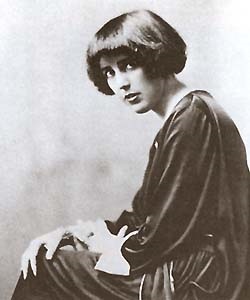Biographical Database of Militant Woman Suffragists, 1913-1920
Biographical Database of NAWSA Suffragists, 1890-1920
Biography of Louise Bryant, 1885-1936
By Vanessa Covert, Undergraduate, Tompkins Cortland Community College
Poet, journalist, arrested in 1919 NWP Watchfire demonstration
Louise Mohan was born on December 5, 1885 into the family of Hugh Mohan, a journalist and minor politician, and Louisa Flick in San Francisco, California. When Louise was about four years old her parents divorced and she spent a good amount of her childhood on a ranch near Reno, Nevada living with her mother and her stepfather, Sheridan Bryant. Louise eventually took her last name from him, a brakeman and a freight train conductor.
Louise Bryant's flirtatious traits and natural beauty helped her throughout her life as a suffragist and activist. She attended the University of Oregon where she found her passion for women's suffrage. She graduated in January 1909 with a degree in history.
After a brief marriage to Paul Trullinger, an affluent dentist, Bryant met Sara Bard Field, the principal mover and shaker of the Oregon suffrage crusade, in 1912. She encouraged Bryant to become an active suffragist, urging her to use her ability to write as well as her intellectual speaking skills in Oregon's women's suffrage movement. In the History of Woman Suffrage, vol. 6, Mrs. Louise Trullinger was listed as a member of the Literature Committee of the state suffrage association.
Bryant's writing ability is also what drew together Louise Bryant and John Reed, a socialist writer and author of a popular first-hand account of the Russian revolution, Ten Days That Shook the World. Reed was a well-known writer for a variety of publications and had interests in a range of topics. Although he influenced Bryant's writing in politics, Reed was not a significant socialist influence on Bryant and did not directly influence her feminism.
A year after they met, the couple traveled to Russia where they wrote for The Masses, a socialist magazine that covered many topics, including feminism. Louise had a different view of feminism than the rest of the women working for The Masses. She viewed the goal of feminism as gaining equality between the sexes while other women thought that the purpose of feminism was to gain power over men. Bryant's looks and intellect were threatening to some of the other women working for The Masses.
Bryant returned to the United States in February 1918, while Reed remained to report on continuing developments in the Russian Revolution. From New York, Bryant continued to write about the Revolution, calling on her readers to support the revolutionaries. While in Washington, D.C. for a speaking engagement, Bryant joined the Watchfire demonstrations outside the White House. Arrested in February 1919, she was sentenced to five days in District jail. She served three days of her sentence and joined the hunger strike initiated by the NWP suffragists. She testified before a Congressional committee and undertook a nationwide speaking tour, calling on the U.S. to stop opposing the Russian Revolution.
Reed returned to the United States in the summer of 1919 and then returned to Russia to represent the newly organized Communist Labor Party before the Communist International. Caught in the fighting between the Bolsheviks and the U.S.-supported anti-Bolsheviks, he was arrested and jailed in March 1920, but then released. While attending a multi-ethnic People's Congress in Baku, Reed fell ill with typhoid fever. On October 19, 1920, at the age of thirty-three, John Reed died in Moscow. Bryant had returned to Russia to rejoin Reed, but only managed to reconnect with him in the final stage of his decline. She returned to the United States in the summer of 1921, but soon returned to Russia, writing articles and then a book, Mirrors of Moscow (1923).
Bryant eventually married the Assistant Secretary of State, William Christian Bullitt. Once married, Bryant and Bullitt's relationship turned complicated. They had one child, Anne Moen Bullitt, but in 1924, they suffered a difficult divorce. Bryant became a heavy drinker and started a same sex-affair with the sculptor Gwen Le Gallienne. Bryant relinquished custody of Anne to Bullitt. On January 6th, 1936, while climbing the stairs to her hotel room in Paris, Louise Bryant succumbed to a hemorrhage and fell to her death.
Sources:
Doris Stevens, Jailed for Freedom (New York: Boni and Liveright, 1920), p. 356; Virginia Gardner, "Friend and Lover": The Life of Louise Bryant (New York: Horizon, 1982); Mary V. Dearborn, Queen of Bohemia: The Life of Louise Bryant (Boston: Houghton Mifflin, 1996). A biography and a photograph can be found online at http://www.oregonhistoryproject.org/articles/biographies/louise-bryant-biography/ and at the "Oregon Cultural Heritage Commission," Oregon Cultural Heritage Commission at http://www.ochcom.org/bryant/.

Photo from: Mary Dearborn, "Reviving Louise Bryant" (2002), accessed at the website of the Oregon Cultural Heritage Commission, at http://wee.ochcom.org/bryant
